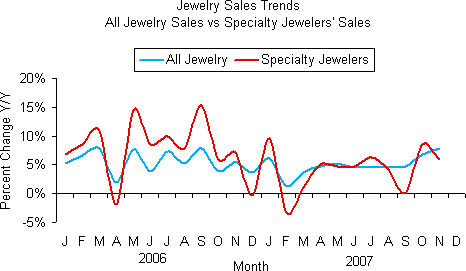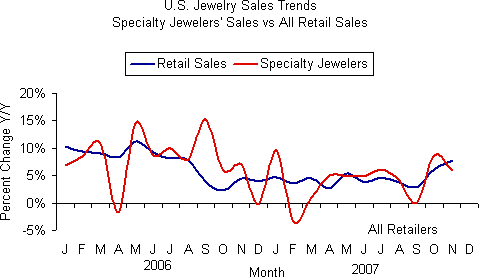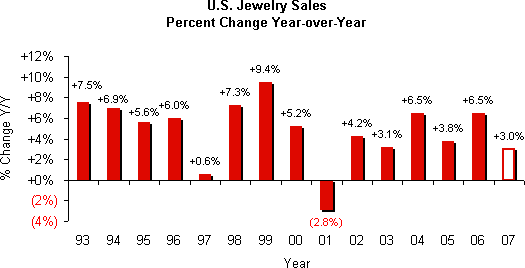IDEX Online Research: U.S. Gov’t Says November Jewelry Sales “Strong,” Jewelers Say “Wrong”
January 22, 08
We wonder sometimes if the bureaucrats at the Department of Commerce in Washington DC are using all of their ten fingers and ten toes when they add up the numbers that go into their monthly retail sales reports.
In fact, that’s exactly what we wondered when we analyzed the retail sales numbers for November 2007.
Both the Department of Commerce and the Bureau of Economic Analysis agree: November was a strong month for jewelry sales in America – up by roughly 6-7 percent.
But most specialty jewelers would take a different view: November was a very tough month, with sales generally flat to down slightly. This was followed by an even more dismal December, when sales were down by 7-8 percent at a majority of mass market jewelers.
Granted, the government’s November numbers are preliminary. They will be adjusted at least a half dozen times over the next twelve months. But, directionally, they really won’t change much during those many revisions.
Whether we agree with the numbers or not, here’s the official pronouncement for jewelry sales in the month of November 2007 from the U.S. Department of Commerce and the Bureau of Economic Analysis:
November 2007:
Total U.S. Jewelry Sales – +7.8 percent
Total Sales of U.S. Specialty Jewelers – +5.9 percent
Here are the details:
- Total Jewelry Sales +7.8 percent – Total U.S. jewelry sales during November 2007 were up nearly 8 percent over the same month a year ago, according to the Bureau of Economic Analysis. This was by far the largest monthly gain in 2007. Further, it was ahead of the gain in total retail sales of +6.8 percent for all goods. By contrast, October jewelry sales were up a more modest but still very strong 6.8 percent (an upward revision from preliminary data), while total retail sales were up 5.7 percent.
Several negative factors pressured consumers’ pocketbooks – mortgage woes, higher gasoline prices, a softening economy and modest wage gains. However, government data, based on consumer surveys, reports that shoppers bought jewelry despite a number of negative factors. - Specialty Jewelers’ Sales +5.9 percent – U.S. specialty jewelers posted a strong sales in November – nearly a 6 percent gain. IDEX Online uses seasonally unadjusted numbers to calculate sales trends, since it reflects “dollars through the cash register” and most closely relates to jewelers’ monthly sales numbers. The good news is that some jewelers must have posted strong gains in November, since the Department of Commerce uses an excellent sampling method to determine retail sales. The bad news is that we don’t know who those jewelers were.
On a trailing twelve-month basis, specialty jewelers’ sales in the U.S. market are up about 3.6 percent.
The table below summarizes sales trends for the past three months.

Source: Various
On a year-to-date basis, total U.S. jewelry sales are up by about 4.9 percent, while specialty jewelers’ sales are up by about 4.2 percent. This reflects trends of prior periods which indicate that specialty jewelers continue to lose market share to discounters, mass market merchants, and other retailers whose primary business is not jewelry.
Outlook: 2008 Could Be Disappointing for Jewelers
Two months ago, we reduced our annual jewelry sales forecast to a 3 percent gain. We are leaving that forecast unchanged. Despite the official government numbers, jewelry demand was weak during the all-important holiday selling season.
What’s important now: the outlook for 2008. There are as many economic forecasts as there are economists. Consensus predictions seem to call for a 50 percent or greater chance of a recession in America.
How will the U.S. jewelry industry fare in a recession? Historically, when the economy is on the upswing, jewelry demand soars. Conversely, when the economy slows, jewelry demand plummets.
The good news is that the U.S. Fed is trying to engineer a soft landing. If the U.S. can weather a recession in the early part of 2008, a recovery could begin in the second half of the year. That would set the stage a better 2008 holiday selling season.
At this point, we haven’t published our 2008 jewelry sales forecast, but it is likely to reflect very soft demand. There is one offsetting factor: inflation. Inflation in the jewelry industry is soaring due to the pass-through of higher precious metals prices. We expect that our sales forecast for 2008 will show a modestly positive gain, but it will all come from inflationary pricing.
November Jewelry Sales Up Solidly
For the past three months, U.S. jewelry sales have been on the upswing, according to the official government figures. We are reasonably comfortable with jewelry sales figures for September and October. Unfortunately, we believe that November figures will be subject to significant revision downward. Jewelry demand by U.S. shoppers has been – and will likely remain – weak.
The graph below compares specialty jewelers’ sales trends to total jewelry sales trends in the U.S. market. As the graph clearly illustrates, jewelry sales at specialty jewelers has been on a roller coaster ride for the past few months.
 Source: U.S. Dept of Commerce |
November Specialty Jewelry Sales Weaker Than Total Retail Sales
During November, specialty jewelers in the U.S. market experienced a more modest sales gain than the average gain for all retail sales categories (ex-automobiles). This is no surprise: this was a month in which consumers focused their shopping in big-box mass market discounters. By confining their shopping to one retailer, shoppers could save time and money on gifts for Christmas, Chanukah and Kwanza.
The graph below summarizes sales trends for all retail goods (excluding food and automobiles) versus specialty jewelers’ sales. Why do we eliminate “automobile” sales? Monthly auto sales are driven largely by consumer incentives rather than by underlying economic factors.
 Source: U.S. Dept of Commerce |
Over the long term, auto demand trends are an important indicator of consumer vitality; however, on a month-to-month basis, auto demand is dependent on manufacturers’ incentives such as zero percent financing, cash-back offers and other deals. Food sales are far less cyclical and can mask changes in consumer demand; thus, we eliminate them, too.
Consumer Spending Continues Stronger
Driven by retail demand as well as price inflation of core commodities such as gasoline, October consumer expenditure trends showed an up tick over the average gain for the year. Consumer spending was up about 6.8 percent in November, versus the year-to-date average gain of just over 5 percent. Once again, retail sales were the primary driver of this spending increase; spending on services held about steady during the month.
The graph below summarizes trends in American’s total spending (blue line), retail sales of all goods (black line) and expenditures on jewelry (red line).
 Source: U.S. Dept of Commerce |
Outlook: Our 2007 Final Forecast Remains Bearish
While November jewelry demand appeared to be strong according to the government’s numbers, reports from various jewelers indicate that December jewelry sales ranged from “very weak” to “dismal.”
For 2008, jewelers need to think conservatively. Take a look at jewelry sales for 2001 (graph below) to get an idea of the potential magnitude of 2008’s sales decline, prior to adjusting for inflation in 2008 (there was virtually no inflation in the numbers in 2001).
Our forecast for jewelry sales in the U.S. market remains at +3 percent for the year ending December 2007.

Source: Dept of Commerce NIPA